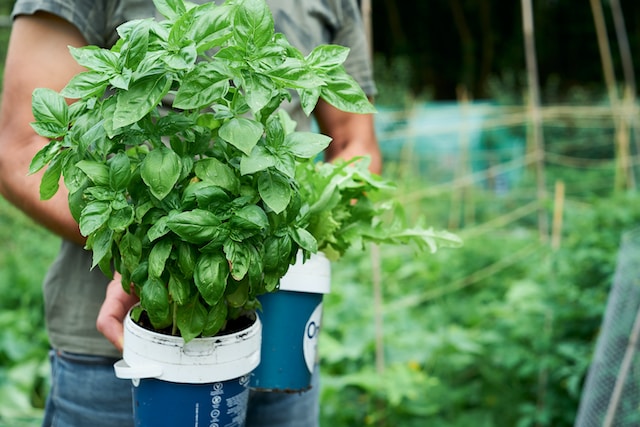
An understanding of herbs is an indispensable asset for any aspiring home cook. These vibrant botanical wonders possess the ability to elevate even the simplest of dishes to new heights, infusing them with flavors and aromas that tantalize the senses. Whether it is the earthy warmth of thyme or the refreshing zest of basil, the world of herbs holds a treasury of culinary delights waiting to be explored.
Within this article, we shall delve into the essential herbs that every home cook should acquaint themselves with – a curated collection of nature’s gifts that will undoubtedly become irreplaceable allies in your culinary pursuits. From traditional staples to exotic gems, this compendium will arm you with knowledge, allowing you to wield these herbs with confidence and finesse.
Basil
Basil, with its vibrant green leaves and enchanting aroma, is a staple herb that has earned a beloved place in kitchens around the world. This herb, known for its versatility and refreshing flavor, adds a touch of Mediterranean charm to any dish it accompanies.
Varieties of Basil: From the classic Sweet Basil to exciting variations like Thai Basil and Lemon Basil, this herb comes in a myriad of flavors and scents. Each variety offers a unique twist, allowing home cooks to experiment with different culinary traditions. Whether you seek the licorice notes of Thai Basil or the citrusy undertones of Lemon Basil, there is a basil variety to suit every taste and occasion.
Culinary Uses: Basil possesses an unmatched ability to elevate the flavor profile of countless dishes. Its fresh and aromatic touch is particularly delightful in salads, pasta sauces, and pesto. Basil leaves can also be sprinkled over pizzas or sandwiched between layers of fresh mozzarella and ripe tomatoes for a classic Caprese salad. In desserts, a sprinkle of finely chopped basil leaves can surprise and delight the palate, creating a harmonious fusion of sweet and savory.
Rosemary
Rosemary, with its needle-like leaves and distinct pine-like aroma, is a quintessential herb that brings an air of Mediterranean charm to any kitchen. This woody herb, known for its robust flavor and versatility, has been cherished for centuries for its culinary and medicinal properties.
Varieties of Rosemary:
- Common Rosemary (Rosmarinus officinalis): This is the classic variety of rosemary, characterized by its erect growth habit, small leaves, and strong flavor. It is the most widely available and commonly used type of rosemary.
- Tuscan Blue Rosemary (Rosmarinus officinalis ‘Tuscan Blue’): With its vibrant blue flowers and more upright growth habit, Tuscan Blue rosemary is a visually striking variety. It has a milder flavor compared to common rosemary, making it a versatile choice for various culinary creations.
- Prostrate Rosemary (Rosmarinus officinalis ‘Prostratus’): Unlike the upright growth of common rosemary, the prostrate variety forms a low, trailing carpet of fragrant foliage. It is an excellent option for cascading over garden walls or as a ground cover in herb gardens.
Culinary Uses: Rosemary is a herb that effortlessly infuses dishes with its distinctive fragrance and flavor. Its robust, slightly resinous taste pairs excellently with meats, especially lamb and poultry. Rosemary sprigs can be used to flavor marinades, stews, and roasted vegetables, infusing them with a delightful hint of the Mediterranean. Additionally, the leaves can be finely chopped and added to bread doughs and savory pastries, providing a unique and aromatic twist.

Thyme
Thyme, with its tiny leaves and delicate flowers, is a versatile and aromatic herb that has been cherished by cooks for centuries. This herb, famous for its warm and earthy flavor, adds complexity and depth to a wide range of dishes, making it a staple in kitchens around the world. In this section, we shall explore the different varieties of thyme, its culinary applications, and tips for growing and nurturing this delightful herb.
Varieties of Thyme: Thyme comes in several varieties, each possessing its own unique aroma and flavor. Common Thyme, with its gentle yet robust taste, is the most widely used variety in cooking. Lemon Thyme, as the name suggests, exudes a citrusy tang that brightens dishes and adds a refreshing twist. Other varieties, such as Orange Thyme and Caraway Thyme, boast distinctive herbal profiles that can enrich everything from roasted meats to hearty stews.
Culinary Uses: Thyme is a herb that effortlessly complements a multitude of dishes, enhancing their flavor profiles with its warm and slightly minty notes. This herb pairs exceptionally well with meats, making it a popular choice for marinades, rubs, and sauces. It also shines in vegetable-based dishes, adding a hint of earthiness to roasted vegetables, sautéed mushrooms, and hearty soups. Thyme leaves can be used fresh or dried, with both forms offering their own unique nuances.
Parsley
Parsley, with its vibrant green leaves and fresh flavor, is a versatile herb that adds a touch of brightness to any dish. From its decorative use as a garnish to its integral role in flavoring sauces and stocks, parsley is a culinary must-have. In this section, we will explore the many facets of parsley, including its different varieties, culinary applications, and tips for growing and nurturing this delightful herb.
Varieties of Parsley: Parsley comes in two main varieties – curly parsley and flat-leaf parsley. While both share a similar taste, the choice between the two often comes down to personal preference and the desired aesthetic for your dish. Curly parsley, with its frilly leaves, is commonly used as a garnish and adds a whimsical touch to plates. Flat-leaf parsley, also known as Italian parsley, has a stronger flavor and is favored by many chefs for its herbaceous notes.
Culinary Uses: Parsley is an incredibly versatile herb that can be used in a variety of ways to enhance the flavors of your dishes. It serves as an excellent complement to meats, adding a refreshing and slightly peppery taste. Chopped parsley can also be sprinkled over roasted vegetables or mixed into salads to provide a burst of vibrant flavor. Parsley also plays a central role in many traditional sauces, such as chimichurri and tabbouleh, lending its unique taste and vibrant color to these culinary creations.
Cilantro (Coriander)
Cilantro, also known as coriander, is an herb that has captured the hearts of food enthusiasts all over the world with its unique flavor and vibrant green leaves. This versatile herb is a staple in many cuisines, from Mexican to Thai, and adds a distinctive layer of freshness to a wide array of dishes. In this section, we will explore the various facets of cilantro, including its culinary uses, varieties, and tips for growing and nurturing this delightful herb.

Culinary Uses: Cilantro is often described as having a bright and citrusy flavor with hints of parsley and mint, making it a refreshing addition to both savory and sweet dishes.
Its leaves, stems, and even seeds can be utilized for different culinary purposes, allowing home cooks to explore its many dimensions.
In Mexican cuisine, cilantro is a key ingredient in salsa and guacamole, where its pungent flavor adds depth and complexity. It also pairs well with seafood, enhancing the flavors of ceviche and fish tacos. In Thai cuisine, cilantro is used in dishes such as green curry and pad Thai, infusing them with its unique aromatic profile.
The seeds of the cilantro plant, known as coriander seeds, have a warm and slightly citrusy taste. They are frequently used as a spice, particularly in Indian and Middle Eastern cuisines. Ground coriander seeds are a common addition to curries, spice rubs, and baked goods, imparting a fragrant and earthy note.
Varieties of Cilantro: Cilantro comes in various forms, each with its own distinct characteristics. The two main types of cilantro are the broad-leafed variety and the fine-leafed variety, also known as Vietnamese cilantro or rau ram.
- Broad-leafed cilantro, with its flat and deeply lobed leaves, is the most commonly used variety in recipes. It has a robust flavor and is well-suited for cooking applications.
- Fine-leafed cilantro, on the other hand, has long, narrow leaves with a more delicate taste. It is often used in Southeast Asian dishes and is particularly favored for its unique citrusy undertones.
Mint
Mint, with its vibrant green leaves and invigorating aroma, is a beloved herb that offers a refreshing twist to a wide array of culinary creations. This versatile herb adds a burst of coolness and brightness, making it a perfect choice for hot summer days or any time you crave a revitalizing touch.

Varieties of Mint: Mint comes in numerous varieties, each with its own unique flavor profile and aromatic qualities. Some of the most commonly known mint varieties include spearmint, peppermint, and chocolate mint.
- Spearmint, with its subtle sweetness and hint of coolness, is a popular choice for herbal teas and cocktails.
- Peppermint, on the other hand, has a stronger and more mentholated taste, making it a favorite for soothing digestive issues or creating invigorating desserts.
- Chocolate mint offers a delightful combination of minty freshness and cocoa undertones, adding a surprising twist to drinks and desserts alike.
Culinary Uses: Mint’s bright and refreshing flavor makes it a versatile herb that can be used in both sweet and savory dishes. Its leaves can be added to salads, salsas, or gazpachos to provide a burst of freshness. Mint is also a fantastic addition to fruity cocktails, lemonades, or mocktails, adding a cooling and aromatic element. In desserts, mint pairs extraordinarily well with chocolate, offering a delightful contrast of flavors. From mint-infused ice creams to chocolate mint brownies, the possibilities are endless when it comes to incorporating this herb into your sweet treats.
Oregano
Oregano, with its fragrant leaves and robust taste, is a culinary powerhouse that has earned a special place in kitchens all over the world. This versatile herb adds depth and complexity to a wide range of dishes, making it an essential ingredient for home cooks seeking to elevate their culinary creations. In this section, we will explore the different aspects of oregano, including its various varieties, culinary uses, and tips for growing and nurturing this delightful herb.
Varieties of Oregano: Oregano comes in several varieties, each possessing its own unique aroma and flavor profile.
- Greek Oregano: The most common variety is Greek oregano, known for its strong and slightly peppery taste. It is widely used in Mediterranean and Italian cuisine, adding a warm and earthy note to dishes like pizza, pasta sauces, and grilled vegetables.
- Mexican Oregano: Another popular variety is Mexican oregano, which has a more intense and pungent flavor, often used in Mexican and Latin American dishes.
Culinary Uses: Oregano is a versatile herb that can enhance the flavor of an array of dishes. Its bold taste pairs exceptionally well with tomatoes, making it a popular choice for tomato-based sauces and soups. Oregano’s aromatic profile also complements meats, such as lamb, beef, and poultry, adding a savory and herbaceous note. Additionally, a sprinkle of dried oregano can lend a delightful depth to roasted vegetables, marinades, and salad dressings.
Dill
Dill, with its delicate feathery leaves and unique flavor, is an herb that adds a refreshing touch to a variety of dishes. This versatile herb is known for its distinct taste, reminiscent of fennel and celery, with a hint of lemony zest. In this section, we will explore the many facets of dill, including its culinary uses, varieties, and tips for growing and nurturing this delightful herb.
Varieties of Dill: Dill comes in different varieties, each with its own distinct characteristics.

- Bouquet Dill is the most common variety, which is known for its abundant foliage and strong flavor.
- Fernleaf Dill is a compact variety that is ideal for container gardening or smaller spaces.
- Mammoth Dill, as the name suggests, produces larger plants with more significant leaves, making it a popular choice for those who crave a bolder dill flavor.
Culinary Uses: Dill’s unique flavor and aroma make it a versatile herb that can be used in a multitude of dishes. Its feathery leaves are often used as a garnish, adding a bright and vibrant touch to salads, soups, and seafood dishes. Dill is a crucial ingredient in traditional recipes such as tzatziki sauce, pickles, and gravlax, enhancing their flavors with its unmistakable taste. Dill can also be dried and used as a flavorful addition to herb blends, spice rubs, or infused oils.
Chives
Chives, with their slender green stalks and mild onion-like flavor, are an often overlooked herb that can bring a subtle yet distinctive touch to a variety of dishes. This versatile herb, belonging to the same family as onions and garlic, can add a touch of freshness and vibrancy to both savory and sweet creations. In this section, we will explore the many facets of chives, including their culinary uses, varieties, and tips for growing and nurturing this delightful herb.
Varieties of Chives: Chives come in several different varieties, each with its own unique attributes. The most common variety is the common chive (Allium schoenoprasum). However, there are also variations such as garlic chives (Allium tuberosum) that have a subtle garlic flavor. Each variety offers a distinct twist, allowing home cooks to experiment with different flavors and nuances.
Culinary Uses: Chives are a versatile herb that can be used in a plethora of ways to enhance the flavor and presentation of your dishes. Their delicate and mild onion-like taste makes them an excellent addition to salads, soups, and creamy sauces. Chopped chives can be sprinkled over mashed potatoes, omelets, or scrambled eggs, providing a burst of freshness and color. They are also often used as a garnish, adding a whimsical touch to appetizers, dips, and seafood dishes.
Sage
Sage, with its velvety leaves and aromatic profile, is an herb that adds a touch of earthiness and warmth to a wide range of culinary creations. This versatile herb has a long history of culinary and medicinal use, making it a valuable asset in any home cook’s arsenal. In this section, we will explore the various facets of sage, including its different varieties, culinary uses, and tips for growing and nurturing this delightful herb.

Varieties of Sage: Sage comes in several varieties, each possessing its own unique characteristics and flavors. The most common variety is the common sage (Salvia officinalis), which has gray-green leaves and a strong, herbal flavor. Other varieties, such as pineapple sage and purple sage, offer different nuances and can add a vibrant twist to your dishes.
Culinary Uses: Sage is a herb that can truly transform the flavor of your dishes with its distinct taste and aroma. Its warm and slightly peppery notes make it a wonderful complement to meats, especially poultry and pork. Sage leaves can be used to flavor roasted chicken or stuffed into pork chops for a delicious burst of flavor. It can also lend a unique twist to vegetarian dishes, such as roasted vegetables or sautéed mushrooms.
In addition to its savory applications, sage can also be used in desserts and beverages. Infusing sage leaves in syrups or teas can add a delightful herbal touch to cocktails or mocktails. Sage leaves can also be fried until crispy, creating a unique and flavorful garnish for soups or salads.
From the vibrant green leaves of basil to the delicate flowers of thyme, each herb possesses its own unique flavor profile and culinary uses. By familiarizing yourself with these essential herbs and incorporating them into your dishes, you can elevate your cooking to new heights and create culinary masterpieces that will leave your loved ones in awe.
